
Lincoln Center, New York City
The American Bicentennial Exhibition
STANLEY ROSEMAN
The PERFORMING ARTS in AMERICA
The PERFORMING ARTS in AMERICA
© Stanley Roseman and Ronald Davis - All Rights Reserved
Visual imagery and website content may not be reproduced in any form whatsoever.
Visual imagery and website content may not be reproduced in any form whatsoever.
Biography: Page 3 continued
the Theatre
Lincoln Center Plaza with the banner
announcing the exhibition
Stanley Roseman - The Performing Arts in America
Library and Museum for the Performing Arts,
Lincoln Center, 1977
announcing the exhibition
Stanley Roseman - The Performing Arts in America
Library and Museum for the Performing Arts,
Lincoln Center, 1977
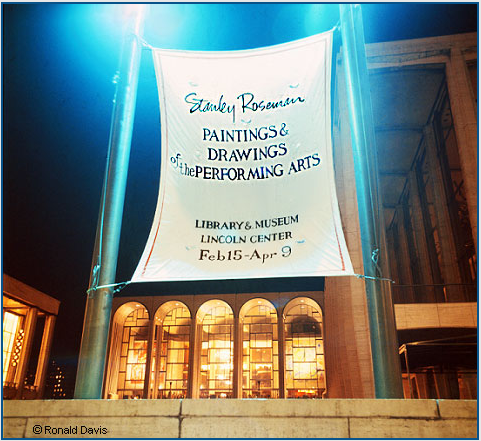

On Broadway
2. Equus, 1975
Pencil on paper, 27 x 21 cm
Collection of the artist
Autographed and inscribed:
For Stanley, affectionately -
Peter Shaffer
July 1975
Pencil on paper, 27 x 21 cm
Collection of the artist
Autographed and inscribed:
For Stanley, affectionately -
Peter Shaffer
July 1975
DRAWINGS account for a great portion of Roseman's oeuvre, evidenced by the artist's concentration on various subject matter and themes, as with his drawings on the performing arts. Roseman's dedication to drawing is in keeping with the belief of Giorgio Vasari, the celebrated sixteenth-century Florentine architect, painter, and author for whom drawing (disegno) is the foundation of the visual arts.[1] Although drawings have traditionally served as studies or drafts in preparation for compositions to be realized in another medium, drawings can be autonomous works of art, as are Roseman's drawings, signed and inscribed by the artist.
Sir Peter Shaffer's Equus, a psychological drama by Britain's distinguished playwright, opened on Broadway in October 1974 and received a Tony Award and New York Drama Critics' Circle Award for Best Play. Roseman drew from the wings at performances Anthony Hopkins and Peter Firth, the critically acclaimed stars of the original Broadway cast; Anthony Perkins and Tom Hulce, who admirably took over the leading roles; and Richard Burton, who brought his impressive performance from the stage to the screen.
The main action of the play takes place in a psychiatric hospital in southern England. A psychiatrist Dr. Martin Dysart probes the mind of the seventeen year-old Alan Strang, who has blinded six horses. While treating his patient, the doctor wrestles with his own feelings of purpose and self-worth as he searches for the reasons for the young stableman's violent actions with their sexual and religious motivations and associations.
Each of the six actors in the role of horses wore over his head a wire construction in the form of a horse's head, the actors' only equine physical identity. Roseman's superb drawing establishes a pictorial reality of what the young man sees and feels - the overpowering presence of the horse with its furry face, flaring nostrils, and eyes that stare out at the viewer.
Roseman recounts in his journal:
''Drawing at Peter Shaffer's drama Equus was a memorable experience that included coming to know the playwright personally. After drawing at a number of performances over several months, I invited Peter Shaffer to dinner with Ronald and me at the apartment and to show the playwright the drawings. That was a most pleasant evening. Peter Shaffer expressed his admiration for my work, and I thanked him very much. I said that I was especially appreciative for his thoughtful compliments as it was his superb play and the great performances that had inspired my drawings. I was deeply moved that in kindly granting my request to autograph a drawing, the eminent dramatist wrote:
Drawing at Equus was for Roseman not only a memorable experience but also a unique experience in his work due to the concept of the production whereby the entire cast remained on stage during the play. In addition to the doctor and his teenage patient, the cast included the young man's parents and girlfriend, a local magistrate, a nurse, stable owner, and the six actors who portrayed the horses. "When cast members were not in a scene," recounts Roseman, "they sat on bleachers arranged on the stage and along with the audience, watched the drama unfold. With the cast on stage throughout the play, I was virtually alone drawing from the wings.
Roseman further recounts his experiences as an artist in the world of the performing arts:
"Anthony Hopkins and Peter Firth thoughtfully invited me to join them and the other members of the cast at the intermissions, which were taken together in a small, common room downstairs in the theatre. The director John Dexter had instructed that the cast remain together during intermissions to maintain the close contact and ambience established on the stage. I am grateful to have been included in such a personal way as part of the company. Coffee, tea, cookies, and cake were kindly provided for all by Eric Harrison, an amiable Englishman who was the company's attentive and considerate Wardrobe Supervisor. Eric was also attentive to me and expressed appreciation for my work, for which I am sincerely grateful.
"Marian Seldes, the highly respected actress who played the lady magistrate, was also appreciative of my art. Thoughtfully, she would tell me to take another serving of cake for sustenance to continue my work. When the intermission was over, the stage manager called the cast to the stage for Act II. With drawing book and pencils, I accompanied the actors upstairs and onto the stage level, and as the cast took their places on the set, I took my place in the wings."
The selection of drawings on the Theatre presented here from the American bicentennial exhibition Stanley Roseman - The Performing Arts in America shows a range in the artist's use of the graphite pencil to express gesture, movement, and physiognomy. The drawings created at theatre productions depict actors in leading roles as well as supporting players and other members of the ensemble.
"When I began drawing at performances of Equus, I received a warm welcome from the cast for which I was very grateful. Anthony Hopkins was outstanding in the role as Dr. Dysart. The renowned actor was a very pleasant man and always greeted me warmly in the wings before he went on stage. Weeks later, after I had been drawing at performances, Anthony Hopkins expressed to me in writing 'much admiration' for my work. I am also grateful to Peter Firth, who as a talented young actor had originated the role of Alan Strang to critical acclaim a year before in the play's London world premiere."
1. Giorgio Vasari, Vasari on Technique, (New York: Dover, 1960), p. 205.
2. Richard Studing, Fantastic Shakespeare, (Stratford, Ontario: The Gallery, 1976).
3. Stanley Roseman - Dessins sur la Danse à l'Opéra de Paris, (text in French and English),
(Paris, Bibliothèque Nationale de France, 1996), p. 11.
4. Peter Pan starring Mary Martin.
5. Les Arts du Théâtre de Watteau à Fragonard, (Bordeaux: Musée des Beaux-Arts, 1980).
2. Richard Studing, Fantastic Shakespeare, (Stratford, Ontario: The Gallery, 1976).
3. Stanley Roseman - Dessins sur la Danse à l'Opéra de Paris, (text in French and English),
(Paris, Bibliothèque Nationale de France, 1996), p. 11.
4. Peter Pan starring Mary Martin.
5. Les Arts du Théâtre de Watteau à Fragonard, (Bordeaux: Musée des Beaux-Arts, 1980).
The John F. Kennedy Center for the Performing Arts, Washington, D.C., invited Roseman in 1975 to draw at a revival of Eugene O'Neill's Long Day's Journey into Night. Premiered in 1956, three years after the esteemed playwright's death, O'Neill's autobiographical drama was awarded a Pulitzer Prize.
8. Zoe Caldwell, 1975
Long Day's Journey into Night
Pencil on paper, 35 x 27 cm
Private collection, Switzerland
Long Day's Journey into Night
Pencil on paper, 35 x 27 cm
Private collection, Switzerland
9. Jason Robards, 1975
Long Day's Journey into Night
Pencil on paper, 35 x 27 cm
Private collection Switzerland
Long Day's Journey into Night
Pencil on paper, 35 x 27 cm
Private collection Switzerland
Long Day's Journey into Night by Eugene O'Neill
at the John F. Kennedy Center for the Performing Arts, Washington, D.C.
at the John F. Kennedy Center for the Performing Arts, Washington, D.C.
Equus by Peter Shaffer
Pacific Overtures by Stephen Sondheim
Roseman created a suite of marvelous drawings at performances of Stephen Sondheim's Pacific Overtures, a Kabuki-style musical about the reopening of Japan to the West in the mid-nineteenth century. Pacific Overtures, premiered on Broadway in 1976 and won the New York Drama Critics' Circle Award for Best Musical.
The drawing A Japanese Peasant, (fig. 5), visually transports the viewer to the Orient. The anonymous figure, seen standing in profile, wears a wide jacket and voluminous trousers. Yet an individual identity is revealed by the prominent nose, small open mouth, and round chin emerging from under the large, broad hat. With a minimum of fluent, pencil lines, Roseman drew an engaging abstraction of a Japanese peasant.
Musical Theatre
Repertory Theatre
The Balcony by Jean Genet
The Classic Stage Company is one of America's leading repertory theatres. Located near Union Square in New York City, the Classic Stage Company, or CSC Repertory, was founded in 1967.
During the run of The Performing Arts in America exhibition at Lincoln Center, Roseman was invited in March 1977 by CSC's Artistic Director and Founder Christopher Martin to draw at the Company's current production of Jean Genet's The Balcony. The thoughtful invitation gave Roseman the opportunity to include in his oeuvre on the performing arts a play by a French dramatist. Drawings from The Balcony were added to the exhibition, which was augmented with the artist's ongoing work on opera, theatre, dance and the circus. The suite of superb drawings from The Balcony is conserved in the Musée des Beaux-Arts of Bordeaux.
Jean Genet's Le Balcon (The Balcony) is considered one of the author's greatest plays. The Balcony was given its American premiere in 1960 and received the Off-Broadway Obie Award for Best Foreign Play. The CSC Repertory presented a successful revival of the play in the 1976-1977 season.
The drama takes place in a brothel in an undisclosed location. The establishment is supervised by Madame Irma. Prostitutes and their clients assume various identities as they maneuver between illusion and reality.
10. Man smoking a cigar, 1977
Classic Stage Company
The Balcony
Pencil on paper, 35 x 27 cm
Musée des Beaux-Arts, Bordeaux
Classic Stage Company
The Balcony
Pencil on paper, 35 x 27 cm
Musée des Beaux-Arts, Bordeaux
11. Noble Shropshire, 1977
Classic Stage Company
The Balcony
Pencil on paper, 35 x 27 cm
Musée des Beaux-Arts, Bordeaux
Classic Stage Company
The Balcony
Pencil on paper, 35 x 27 cm
Musée des Beaux-Arts, Bordeaux
12. Karen Sunde, 1977
Classic Stage Company
The Balcony
Pencil on paper, 35 x 27 cm
Musée des Beaux-Arts, Bordeaux
Classic Stage Company
The Balcony
Pencil on paper, 35 x 27 cm
Musée des Beaux-Arts, Bordeaux
- Philippe Le Leyzour, Chief Curator
Musée des Beaux-Arts, Bordeaux
Musée des Beaux-Arts, Bordeaux
"The Musée des Beaux-Arts of Bordeaux is very honored by the donation of three of your drawings:
Kassya, 1995, Fanny Gaïda, 1996, and Elisabeth Maurin, 1995,
that you have generously offered. They enrich the collection of 20th century drawings
that are conserved in the museum and constitute with the series of the Monks
and The Balcony by Jean Genet an ensemble of very great interest.''
Kassya, 1995, Fanny Gaïda, 1996, and Elisabeth Maurin, 1995,
that you have generously offered. They enrich the collection of 20th century drawings
that are conserved in the museum and constitute with the series of the Monks
and The Balcony by Jean Genet an ensemble of very great interest.''
The Musée des Beaux-Arts, Bordeaux, acquired in 1986 the drawings from The Balcony. The Museum's Chief Curator Philippe Le Leyzour writes in a cordial letter to Ronald Davis:
The Bordeaux Museum had acquired in 1984 the artist's portrait painting of Glen "Frosty'' Little, celebrated American circus clown and Director of Clowns of the Ringling Bros. and Barnum & Bailey Circus. (See "Biography,'' Page 3 - "Spirit of the Clown.'') The acquisitions from Roseman's oeuvre on the performing arts are significant as the Musée des Beaux-Arts, Bordeaux, presented in 1980 a major exhibition Les Arts du Théâtre de Watteau à Fragonard, which included a number of works from the Museum's renowned collection.[5]
- Francis Ribemont, Chief Curator of Patrimony
Musée des Beaux-Arts, Bordeaux
Musée des Beaux-Arts, Bordeaux
7. James Dybas, 1976
Pacific Overtures
Pencil on paper, 35 x 27 cm
Private collection, New York
Pacific Overtures
Pencil on paper, 35 x 27 cm
Private collection, New York
6. Yuki Shimoda, 1976
Pacific Overtures
Graphite and red pencil on paper, 35 x 27 cm
Private collection, Switzerland
Pacific Overtures
Graphite and red pencil on paper, 35 x 27 cm
Private collection, Switzerland
5. A Japanese Peasant, 1976
Pacific Overtures
Pencil on paper, 35 x 27 cm
Collection of the artist
Pacific Overtures
Pencil on paper, 35 x 27 cm
Collection of the artist
3. Richard Burton, 1976
Equus
Pencil on paper, 21 x 27 cm
Collection of the artist
Equus
Pencil on paper, 21 x 27 cm
Collection of the artist
A prolific draughtsman, Roseman employs a variety of drawing materials with great versatility, as seen on the previous page with depictions of celebrated singers in productions at the Metropolitan Opera, New York City Opera, Lyric Opera of Chicago, and the Bolshoi Opera. Drawing with pen, brush, and bistre ink at the American Shakespeare Festival, "Stanley Roseman did a set of exquisite drawings of Morris Carnovsky as King Lear.''[2] (See "Biography'' - Page 2 - "Variety of Drawing Materials and the World of Shakespeare.'')
During the national tour of The Performing Arts in America, drawings were added to the exhibition as Roseman included other companies and performers and returned to companies where he had previously drawn, ''with a seriousness that pushes him always further in treating a subject or theme'' writes the Bibliothèque Nationale de France in a biographical essay on the artist.[3] The addition of new works gave the exhibition an exciting immediacy and was greatly appreciated by the visiting public and the performers themselves, including Richard Burton, who is depicted in the two superb portrait drawings presented below. Roseman recounts:
Drawing Richard Burton in Equus
4. Richard Burton, 1976
Equus
Pencil on paper, 27 x 27 cm
Collection of the artist
Autographed and inscribed:
To Stan
many thanks
Richard Burton
Equus
Pencil on paper, 27 x 27 cm
Collection of the artist
Autographed and inscribed:
To Stan
many thanks
Richard Burton
''Richard Burton took over the role of Dr. Dysart for a limited run in 1976 in preparation for his appearance in the forthcoming movie of Equus, in which Peter Firth reprised his role as Alan Strang. Richard Burton was at that time one of the most famous stars on the stage and screen and his appearance in the play on Broadway was greeted with enormous publicity as well as tight security in and outside the theatre.
"Richard Burton was told of my work on the performing arts and the current exhibition that was on tour for the American bicentennial. I was invited to meet the celebrated actor and brought some slides of the exhibition to show him. Richard Burton was very complimentary about my work and said he was very pleased to have me at the theatre to draw him in performances. Expressing my appreciation, I said that it would be an honor to include drawings of him in my exhibition."
''Richard Burton invited me to his dressing room and scheduled a day and hour when he said he could view the drawings at his leisure. I prepared a selection of drawings in matte boards for a presentation.
"After taking time to look at the work, Richard Burton told me that he would be very pleased to have any of the drawings of himself included in my exhibition. Returning his gaze to a portrait in profile, (fig. 3, above), he gestured with his hands as if putting them around the head of a sculpture and said that he very much liked the sculptural quality of the portrait drawing.
"Pointing to a drawing that depicts him delivering a monologue on stage, Richard Burton exclaimed in his deep, rich voice: 'I can hear myself speaking in your drawing,' (fig. 4). An artist could not ask for a greater compliment from his model, especially when the subject of the work is Richard Burton. I was thrilled. As any admirer of the great actor might do, I asked if I could please have his autograph. 'With great pleasure,' he assured me and took in hand the drawing he had just praised. I was deeply touched at how much my work meant to him when inscribing my drawing he wrote:
'To Stan many thanks Richard Burton.' ''
'For Stanley: affectionately - Peter Shaffer, July 1975.' ''
In February, Roseman began drawing Richard Burton in Equus. The artist recalls the Welsh actor's "commanding stage presence" and "great performances" and further writes: "It was exciting to be in the wings to draw Richard Burton on stage." The artist continues: "I enjoyed a friendly relationship with Richard Burton. He was impressed that I was dedicating an oeuvre to the performing arts and was most encouraging to me in my work. After drawing at performances in February and March, I asked the celebrated actor if he would like to see the drawings. In that famous baritone voice of his, he replied, 'Yes, of course!'
"At the scheduled hour I knocked on the star's dressing room door. He greeted me warmly, as always, and said he was looking forward to seeing the work. After I had unwrapped the package of drawings, he placed them around the room and cleared a space on his dressing table. His enthusiasm alleviated my nervousness in making the presentation. What followed was a most memorable experience.
Jason Robards, renowned actor and interpreter of the works of Eugene O'Neill, had played the role of Jamie in the 1957 American premiere of Long Day's Journey into Night. Robards won further acclaim in the role of James Tyrone, as at the Kennedy Center's revival of the play. Despite his heavy drinking and shabby attire, James Tyrone maintained a semblance of his profession as a classical actor.
The play unfolds with the lively song Please Hello. The arrival of the American, British, Dutch, Russian, and French admirals to sign trade agreements with Japan is met with reluctance by the First Councillor Abe Masahiro, newly appointed Shogun, commendably portrayed by Yuki Shimoda, who is depicted in the fine drawing below, (fig. 6). Roseman renders the distinctive attire and hairdo with curvilinear strokes and geometric shapes and adds accents of red on the eyelids and mouth to evoke Kabuki characterization and makeup.
With the silvery tones of a graphite pencil, Roseman drew James Dybas, who gave a memorable performance as the Old Man recalling an experience in his youth in the wonderful song Someone in a Tree. The venerable personage with the long, wispy beard relates that he hid in a tree to observe the meeting of the Japanese Councillors and the Americans at the Treaty House specifically built for the event. In this compelling drawing, (fig. 7), the Old Man raises his right hand and gestures with an index finger to affirm his story.
Exploring the erotic world of The Balcony in his drawings, Roseman depicts a fascinating array of personalities, such as the mysterious character with head raised and face silhouetted in profile, (fig. 10). The man has long sideburns and wears dark eyeglasses, a large cap with a visor, and a high-collared shirt and puffs on a cigar, held tightly between his lips.
The chiaroscuro modeling of the figure is achieved by dark, parallel strokes of graphite pencil and reserved areas of the white paper. The artist's vigorous rendering of form, shading, and background heighten the sense of drama in this striking work.
The Balcony suite includes a drawing of a seated, haughty female with dark, shoulder-length hair, her dress pulled up above her knees, and her right hand raised and holding a long cigarette holder. A general with angular, facial features and a clipped moustache is seen wearing a spiked helmet and carrying a riding crop. Several drawings depict the Queen's burly, bearded and bespectacled envoy, played by Christopher Martin.
The CSC Repertory's Associate Director and leading actress Karen Sunde as Madame Irma is the subject of a number of excellent drawings in The Balcony suite. Assuming a personage of a queen, as in the drawing above, (fig. 12), she wears a crown, as befitting her "royal'' station. The Queen, with arched eyebrows over heavy-lidded eyes, partly covers her left cheek with the broad collar of her voluminous cloak rendered with calligraphic strokes of the pencil. Here Roseman has drawn a captivating portrait of the brothel's madam.
Roseman composed the drawing with opposing diagonals suggesting the character's inner conflicts. James Tyrone is depicted with head inclined; his left shoulder, hunched; his left arm, raised and bent at the elbow. The actor's left hand holds a cigarette and falls in a relaxed manner by his side. The smoke rising from the lit cigarette is an effective vertical element in the composition.
Presented here, (fig. 9), is the impressive drawing of Jason Robards as James Tyrone. The middle-aged actor is seen in profile with his head lowered to his chest and an intense expression on his face. Strong, pencil strokes accentuate the knitted brow; protruding, lower lip; and dark moustache.
A young actor Noble Shropshire, who played a judge, photographer, and revolutionary, is depicted in performance lying on his back, his face in profile and turned upward, (fig. 11). The composition has a strong diagonal and bold use of pictorial space. In this impressive drawing Roseman effectively renders shading on the reclining figure by parallel hatching with varying strengths of the pencil line.
The celebrated actress Zoe Caldwell gave a deeply moving performance as Mary Tyrone, a middle-aged woman whose addiction to morphine was caused by a negligent doctor who prescribed the drug as a pain killer, an addiction that returns during the course of the play.
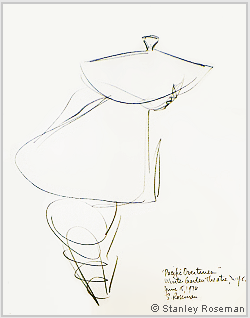
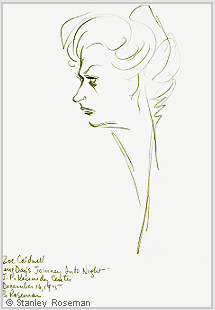
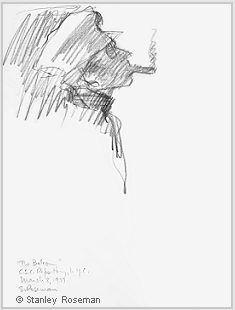
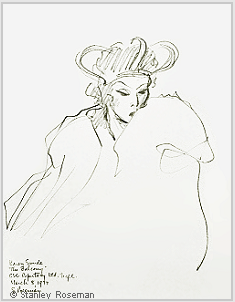
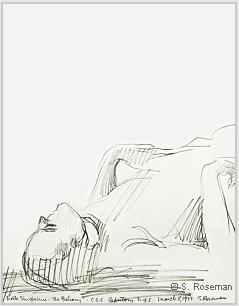
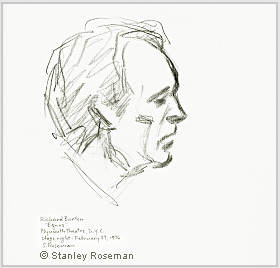
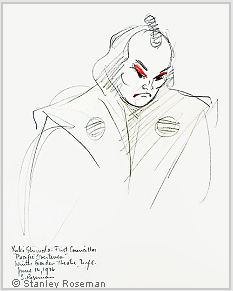
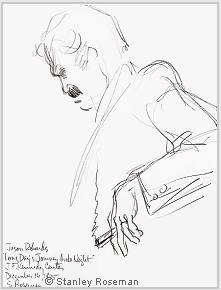
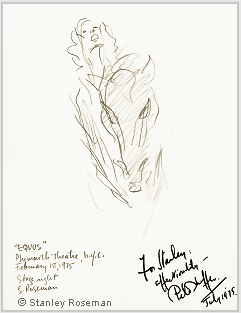
Roseman depicts in the drawing, (fig. 8), a moment when Mary Tyrone turns her face abruptly towards her husband James, an unfulfilled actor of the classical theatre; her alcoholic, elder son, Jamie; and consumptive, youngest son, Edmund. In this arresting portrait, Mary Tyrone is seen in profile. Her upswept hair drawn with lyrical lines contrasts with darker, pencil strokes describing a knitted brow, set mouth, and fixed gaze that reveal anger and frustration as the wife and mother tries to conceal a recurrence of her drug addiction with which she relives in her mind happier days of years past.
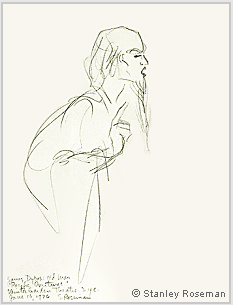
Highly charged with emotion and psychological impact, Roseman's drawing, presented here, (fig. 2), depicts Peter Firth as Alan Strang, with head back, eyes closed, and mouth open as he rides his favorite horse Nugget at a dramatic moment in the play. Swift, pencil strokes convey a sense of movement in the drawing. The young man's neck is strained upward. His long hair, flowing like a horse's mane, is drawn with calligraphic lines. The diagonal composition heightens the impression that the horse is about to rear and advance forward in pictorial space.
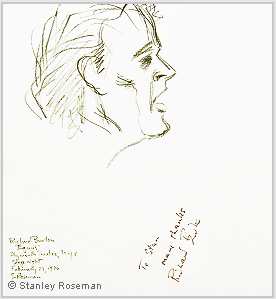
Roseman, raised in New York City and Westchester County, was introduced at an early age to the musical theatre on Broadway. The artist writes in his journal: "I was nine years old when my father took me to my first Broadway musical Peter Pan, which opened in 1954.''[4] From mid-1950 to mid-1960, Roseman attended over forty Broadway musicals. "I am very grateful to my father for having provided me with a most wonderful experience of the American musical theatre.'' Sustaining a love for the theatre in his professional career, Roseman returned to Broadway in the 1970's with invitations to draw at performances of Chicago, starring Gwen Verdon; Hello, Dolly! with Pearl Bailey heading an all-black cast; Ethel Merman and Mary Martin at their gala On Broadway; and a revival of My Fair Lady, one of the shows Roseman saw in his youth.
"I thank you immensely for your very kind letter of March 6. It would be a great pleasure
for the Bordeaux Museum to receive a donation of the series of drawings by Stanley Roseman
from the production of The Balcony by Jean Genet.
I will be delighted to meet you soon."
for the Bordeaux Museum to receive a donation of the series of drawings by Stanley Roseman
from the production of The Balcony by Jean Genet.
I will be delighted to meet you soon."
The Museum's first acquisition of Roseman's work, in 1982, was of three drawings from the artist's oeuvre on the monastic life. In 1986 the Museum made further acquisitions of Roseman's drawings. From the artist's drawings on the dance at the Paris Opéra are star dancers Fanny Gaïda in La Bayadère and Elisabeth Maurin in Romeo et Juliette. (See "Variety of Drawing Materials and the World of Shakespeare.") Also included in the acquisition is a chalk drawing of the Russian clown Kassya in the French theatrical production Sur la Route de Sienne, which combines aspects of circus and commedia dell'arte. (See "Spirit of the Clown, Paris.'') The Chief Curator of the Bordeaux Museum of Fine Arts writes in a letter of appreciation to Roseman: